Shocker 4K Blu-ray Movie
HomeShocker 4K Blu-ray Movie 
4K Ultra HD + Blu-rayShout Factory | 1989 | 109 min | Rated R | Oct 29, 2024
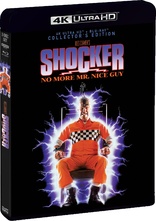
Movie rating
6.1 | / 10 |
Blu-ray rating
| Users | 4.0 | |
| Reviewer | 4.0 | |
| Overall | 4.0 |
Overview
Shocker 4K (1989)
After being sent to the electric chair, a serial killer uses electricity to come back from the dead and carry out his vengeance on the football player who turned him in to the police.
Starring: Michael Murphy (I), Peter Berg, Camille Cooper, Mitch Pileggi, Richard Brooks (VI)Director: Wes Craven
| Horror | Uncertain |
| Thriller | Uncertain |
| Comedy | Uncertain |
Specifications
Video
Video codec: HEVC / H.265
Video resolution: 4K (2160p)
Aspect ratio: 1.85:1
Original aspect ratio: 1.85:1
Audio
English: Dolby Atmos
English: Dolby TrueHD 7.1 (48kHz, 24-bit)
English: DTS-HD Master Audio 5.1 (48kHz, 24-bit)
English: DTS-HD Master Audio 2.0 (48kHz, 24-bit)
Subtitles
English SDH
Discs
Blu-ray Disc
Two-disc set (2 BDs)
4K Ultra HD
Packaging
Slipcover in original pressing
Playback
Region A (B, C untested)
Review
Rating summary
| Movie | 3.5 | |
| Video | 4.5 | |
| Audio | 4.0 | |
| Extras | 4.5 | |
| Overall | 4.0 |
Shocker 4K Blu-ray Movie Review
Reviewed by Dr. Stephen Larson November 9, 2024After he made The Serpent and the Rainbow (1988), Wes Craven formed his own production company under the auspices of Alive Films where he inked a multi-picture contract, working closely with his assistant, Marianne Maddalena (who became one of his regular producers). Like John Carpenter during this same period at Alive Films, Craven was granted complete creative control on his movies courtesy of executive producer Shep Gordon, who gave the genre directors a free hand. Some years earlier, Craven was developing an idea for a series titled Dreamstalker. Kyle Counts wrote in the autumn 1989 issue of Horrorfan magazine that Craven's concept was based on a male character who was electrocuted but failed to die. The man became rejuvenated and transported himself into other people's bodies "as pure electrical energy." Each week the character would take on another body or assume a different identity. 20th Century Fox Television had planned to develop the series but, according to Counts, the studio foresaw difficulties in expanding Craven's premise so the series fell through. Craven elected to make it into a feature instead by fleshing out the second act and adding a third act. His script, No More Mr. Nice Guy, later morphed into Shocker. In an archival commentary rehashed on these two recent discs from Scream Factory, Craven stated that Jack Sholder's The Hidden (1987) was an inspiration for Shocker. But in Counts's article on Shocker for Horrorfan, Craven all but admits that his treatment for Dreamstalker, which apparently contains several similarities to The Hidden, was written before the release of Sholder's film.
Around this same time, Craven's director friend Sean Cunningham had a similar idea for House III. Craven envisaged this as more than just a coincidence and confronted his filmmaking pal on whether or not he purloined any ideas from the Dreamstalker script. “I had long conversations with Sean, and he claimed that his idea had been around a long time," author Joseph Maddrey quoted Craven as saying in his recent book, The Soul of Wes Craven. "He [Cunningham] was not able to produce registered copies of the idea and at a certain point I left it at that. He gave me his word that he would never steal from me, and I believe him” (p. 264).
For an analysis of Shocker, you may consult a review of Scream Factory's 2015 "Collector's Edition" by my colleague Jeff Kauffman.
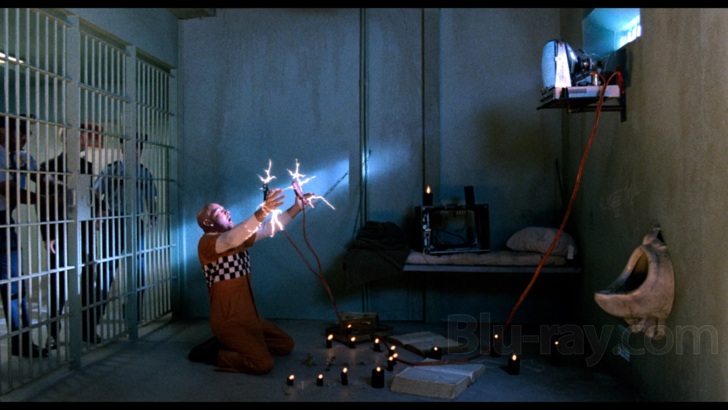
Pinker likes to practice electroshock therapy on himself.
Shocker 4K Blu-ray Movie, Video Quality 

Note: Twenty-five of my screen captures are pulled directly from the UHD disc and downsampled to 1080p. They don't encompass the full HDR and are not representative of the film's color values when projected at 2160p.
Scream Factory's new "Collector's Edition" of Shocker arrives as a 4K Ultra HD + Blu-ray combo, which is housed with a slipcover duplicating the original theatrical poster art. The transfers are based on a 4K restoration from the original camera negative. The UHD is presented in Dolby Vision (HDR10 compatible). The picture appears in its native aspect ratio of 1.85:1. The transfer Jeff reviewed over nine years ago was likely sourced from a 2K scan of the interpositive, which Universal supplied to Scream. Jeff noted noted that a high degree of filtering was applied to the DI. Fortunately, no noise reduction is present here. In fact, I would go on record to say that the grain field is as prominent as most of the 4K transfers Shout! Factory has done in the last couple of years. Grain is thick but not too coarse. I noticed very small, dot-like white specks in a few shots. The DV and HDR truly come to life in the scene where Jonathan Parker (Peter Berg) is standing at a concession stand on his college campus. The red on the ketchup bottle as well as a few of the other brighter colors really pop out. (See Screenshot #21.)
I have incorporated ten screen captures from MCA Home Video's open-matte 1.33:1 LaserDisc transfer so you can see the sharp uptick in color on the 4K and also compare framing differences. The scene on the LD where Alison Clement (Cami Cooper) and her girlfriends watch Jonathan at a football practice has mid-range brightness compared to the 4K and new Blu-ray (cf frame grab #26 with #s 27 and 28). That shot is rather excessively bright (with the sun shining) on the UHD. This and similar shots remind me of some overly bright shots Shout had on its 4K transfer of Matinee. Skin tones have a warmer complexion on the 4K. (Compare screen cap #s 16-19.) The UHD boasts super-crisp black levels. Check out the interior shot (#34) where Lt. Don Parker (Michael Murphy) and police officers break into Horace Pinker's (Mitch Pileggi) TV repair shop. Contrast is manifestly superior on the 2160p and 1080p transfers. Look at how clearer Jonathan and his surroundings are by the lake (cf #s 39 and 40 with #38).
Craven has stated that Shocker was the first film in which he made considerable use of optical effects. The tight shooting schedule precluded the effects from looking as good as they could have (even though the visual effects team worked on them for four months), but they are still decently rendered on the new transfers. Steve Biodrowski wrote a piece in the November 1989 issue of Cinefantastique, which discussed the optical effects supervised by Bruno George. George developed a method of utilizing video technology to extract mattes from film footage. Biodrowski notes that the video sequences for Shocker were shot on videotape. The matte work depicts Pinker and later Jonathan within the realm of TV with their inserts appearing in stock footage of a Vietnam War documentary and a game show. Motion-control techniques were employed to optically matte Pinker when he shows up in the real world. Craven explained to Biodrowski that he wanted Pinker "to be plasmic—visible but transparent." Craven extrapolated on the motion control system to the aforementioned Kyle Counts of Horrorfan magazine: ''The camera is on a hot head that's connected to a computer so that after you finish the scene you shoot the scene again using the same precise moves frame for frame with nobody on the set," Craven explained. ''Then you pull a traveling matte off Mitch and drop that matte in over the empty set, and you pull out what's behind him as a matte, and suddenly he's transparent. We got into tremendous technical virtuosity moves based on Bruno [George]'s knowledge of what was possible. We'll be going back and forth between film and high-resolution video techniques. It's fun; it's like going in and out of dreams, only it's television." Fangoria's Marc Shapiro interviewed Bruno George to obtain his perspective. George stated that his VFX team applied a "computer-accurate motion control system to record a move with the actors in it, play back the move on a blank set, compare it with the information on the set with the actors, and then isolate the actors. This way, we were able to derive a sort of traveling matte. Shooting Pinker on those mattes, we were able to isolate him and give him a processed transparent look."
Shocker on a BD-100. The transfer boasts a mean video bitrate of 80.3 Mbps with an overall bitrate of 93.2 Mbps for the full disc. The MPEG-4 AVC-encoded BD-50 carries an average video bitrate of 31000 kbps. The standard twelve scene selections accompany the 109-minute feature on both discs.
Screenshot #s 1-15, 17, 19, 21, 23, 25, 28, 31, 34, 37, & 40 = Scream Factory 2024 4K Ultra HD BD-100 (downscaled to 1080p)
Screenshot #s 16, 18, 20, 22, 24, 26, 29, 32, 35, & 38 = MCA Home Video 1990 LaserDisc (1.33:1)
Screenshot #s 27, 30, 33, 36, & 39 = Scream Factory 2024 BD-50 (from 4K restoration)
Shocker 4K Blu-ray Movie, Audio Quality 
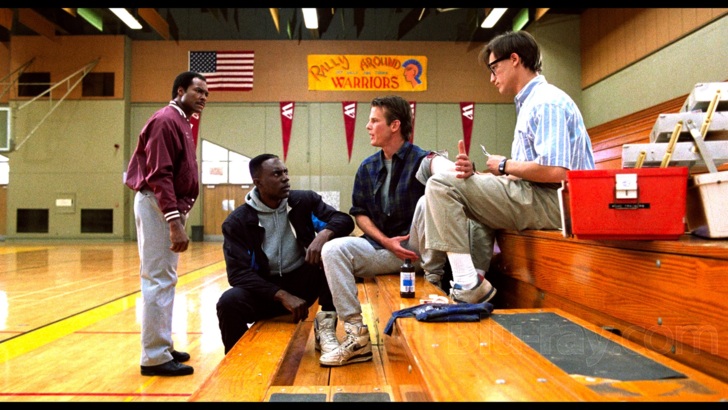
Scream has supplied three audio track options to watch Shocker with on UHD and Blu-ray (in addition to two archival commentaries): a new Dolby Atmos mix (Dolby TrueHD 7.1 compatible with a standard bitrate of 2959 kbps) encoded at an average bitrate of 3599 kbps and a maximum bitrate of 3729 kbps; a DTS-HD Master Audio 5.1 Surround remix (3885 kbps, 24-bit); and a DTS-HD Master Audio 2.0 Stereo mix (2013 kbps, 24-bit). I listened to all three tracks with special concentration on the Atmos and stereo mixes. While listening to the Atmos, the front stage sports excellent bass when The Dudes of Wrath perform "Shocker" and also when Megadeth sings "No More Mr. Nice Guy." Sound f/x are emphasized in the fronts throughout the presentation. I did hear chirping birds and the occasional thunderclap along the rears. But the back surrounds and overheads don't really use the height channels much. I found the side speakers along the front frequently active. They demonstrate outstanding range. In addition, I also sampled a number of scenes on the 5.1 track. Spoken words are clear and audible at just the right pitch. Balance is pretty solid.
I played both the DTS-HD MA 2.0 and the Ultra Stereo mix on the LaserDisc. The stereo track on the UHD and Blu-ray is good but the matrixed surround mix on the LD is definitely superior. The treble is great and delivery is ultra-clear. While the fronts and rears were not always active, the LD delivers reverbs coming out of the mono surrounds at a higher frequency than Scream's stereo mix. Sound f/x are more clearly accented on the LD. The satellite speakers on the UHD and Blu-ray do bring out lightning strikes and raindrops but they're only employed on a few occasions.
I appreciate William Goldstein's electronic score more and more as I listen to it on the optical discs and on Varèse Sarabande's score album. Goldstein wrote a leitmotif for the Pinker character that has synthesizers delivering a scampering-around effect, foreshadowing Pinker's imminent attacks. The composer also wrote a lovely melody that represents Jonathan's foster-care family and Alison.
Scream's optional English SDH is almost 100 percent complete. (It's only missing a "Hey" at the beginning of one line.) The subtitle track also clarified when Jonathan is saying "Don" rather than "Dad," which was pretty much all the time.
Shocker 4K Blu-ray Movie, Special Features and Extras 
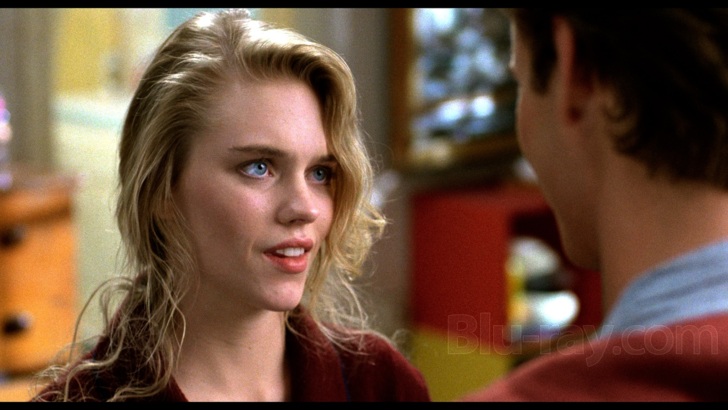
Scream has retained all bonus features from its 2015 CE and produced three new, relatively brief interviews courtesy of Justin Beahm's Reverend Entertainment. For summaries of the previous extras, please refer to Jeff's original review.
DISC ONE: 4K UHD
- Audio Commentary with Director of Photography Jacques Haitkin, Co-Producer Robert Engelman and Composer William Goldstein
- Audio Commentary with Writer/Director Wes Craven
DISC TWO: Blu-ray
- Audio Commentary with Director of Photography Jacques Haitkin, Co-Producer Robert Engelman and Composer William Goldstein
- Audio Commentary with Writer/Director Wes Craven
- NEW Shock Me – An Interview with Actor Peter Berg (9:45, 1080p) - Berg has a photographic memory as he's able to recall the exact times he auditioned for the lead of Jonathan Parker in Shocker. He discusses working with Mitch Pileggi and Michael Murphy as well as the scenes they filmed together. Berg is most appreciative of Craven, whose filmmaking methods and techniques he's used as a director. In English, not subtitled.
- NEW The Chaos and the Calm – An Interview with Composer William Goldstein (8:55, 1080p) - Goldstein describes in considerable detail his musical background and composing methods. He recalls the Twilight Zone episode he scored, which Craven directed in the mid-Eighties. Goldstein covers computers and electronics in music production, sound modules, MIDI and the software he employed for the main titles in Shocker. Excerpts from Goldstein's score are also played. In English, not subtitled.
- NEW She's Electric – An Interview with Production Designer Cynthia Charette (8:36, 1080p) - Charette explains how she first became acquainted with Craven around the time she worked on Pumpkinhead (1988). She delves into how she designed sets inside the following locales: Pinker's TV repair shop, the state prison and execution room, one of the TV tubes, TV antennas on the roof, and the large microwave dish. Several of Charette's original design sketches are shown. In English, not subtitled.
- Cable Guy – An Interview with Actor Mitch Pileggi (17:36, 1080p)
- Alison's Adventures – An Interview with Actress Cami Cooper (17:12, 1080p)
- It's Alive – An Interview with Executive Producer Shep Gordon (11:57, 1080p)
- No More Mr. Nice Guy – The Music of Shocker (26:13, 1080p) - featuring interviews with music supervisor Desmond Child and soundtrack artists Bruce Kulick, Jason McMaster, Kane Roberts, and Dave Ellefson.
- Theatrical Trailer (1:29, upconverted to 1080p) - Universal's official trailer for Shocker presented in 1.78:1 anamorphic widescreen. The trailer has not been restored.
- TV Spots (1:04, upconverted to 1080p) - two pre-release TV spots for Shocker. They appear in 1.33:1 and are of acceptable quality.
- Radio Spots (1:09)
- Vintage Making of Featurettes (2) (8:48, upconverted to 1080i)
- Storyboard Gallery (8:55, 1080p) - these storyboards sketched by Marc Baird are shown in illustrations for four scenes in Shocker for which they were intended. They are presented in landscape mode and accompanied by audio from the film's original sound track, which is pretty well synchronized to the drawings. The storyboarded scenes include: "Football Practice," "You Got It, Baby!" "Lounging Around," and "Pinker at the Park."
- Still Gallery (6:32, 1080p) - a moving slide show consisting of seventy-five high-res stills from the production of Shocker. Fifty-two of the first fifty-three images comprise still photographs taken on set of Shocker as well as publicity snapshots of Peter Berg, Camille Cooper, and Michael Murphy. The last twenty-two includes poster art, newspaper adverts, pictures from Universal's press kit, and several photos of Craven working on the film.
Shocker 4K Blu-ray Movie, Overall Score and Recommendation 
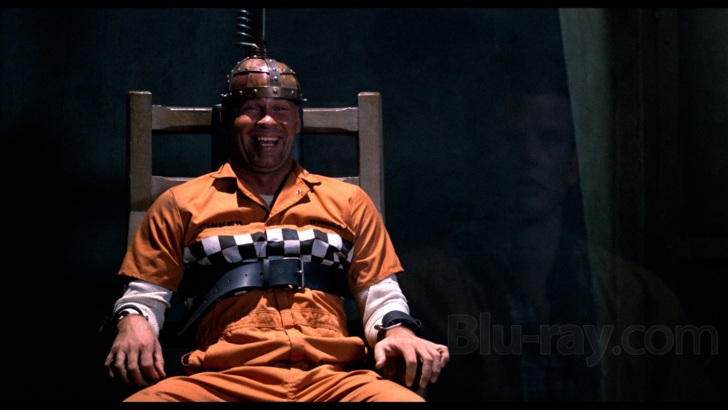
Shocker (1989) is a very good horror/black comedy from Wes Craven. I can see how it could have influenced the filmmakers who made Jason Goes to Hell (1993). Indeed, there are electronic elements in Goldstein's score that remind me of Harry Manfredini's thematic material for New Line's first Friday production. Scream Factory's 4K UHD is incredibly film-like with deep blacks and vivid colors occasionally popping up. I appreciated the label including a Blu-ray because it includes a few scenes that are not as bright. Of the three audio presentations I listened to, I prefer the new Dolby Atmos mix. The 2.0 stereo mix is solid but not as dynamic as the LaserDisc's audio track. Supplements from the 2015 CE are retained here along with three recent interviews that are relatively brief but still informative. (I wish that Peter Berg's interview could have been longer.) A PRETTY STRONG RECOMMENDATION. I hope that either Arrow or Scream commissions a 4K restoration of Craven's underrated Deadly Blessing (1981).
Similar titles
Similar titles you might also like

Hatchet
Unrated Director's Cut
2006

Witchboard
1986

Hatchet III
2013

Jeepers Creepers 2
Collector's Edition
2003

Scary Stories to Tell in the Dark 4K
2019

Urban Legends: Bloody Mary
2005

Detention
2011

Halloween II
Unrated Director's Cut
2009

Victor Crowley
Hatchet IV
2017

Child's Play
2019

The Gallows
2015

All the Boys Love Mandy Lane
2006

Jackals
2016

Otis
Uncut
2008

Poltergeist 4K
1982

Child's Play 4K
1988

All Cheerleaders Die
2013

Bride of Chucky 4K
Collector's Edition
1998

Seed of Chucky 4K
Collector's Edition
2004

House of Wax
Collector's Edition
2005
